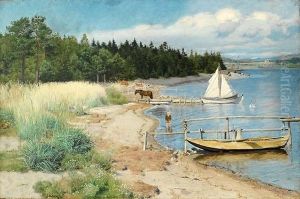Andreas Schelven Sc. Bloch Paintings
Andreas Schelven Sc. Bloch, commonly known as Andreas Bloch, was a Norwegian artist, illustrator, and painter, noted for his contributions to Norwegian visual culture during the late 19th and early 20th centuries. Bloch was born on November 29, 1860, in Stavanger, Norway, and grew up in a period when the country was undergoing significant cultural and political changes, moving towards independence from Sweden.
Bloch's artistic journey began at a young age, and he pursued his passion for art by studying at the Norwegian National Academy of Craft and Art Industry in Christiania (now Oslo). He further honed his skills at the Royal Academy of Art in Munich, Germany, where he was influenced by the prevailing realistic styles of the time.
Throughout his career, Bloch became known for his illustrations in books, newspapers, and magazines. His works often captured scenes from Norwegian history, folklore, and everyday life, reflecting a strong national romantic sentiment. He was particularly adept at depicting historical events and figures, bringing them to life with a keen eye for detail and a rich narrative quality. His illustrations were not only artistically significant but also served to foster a sense of national identity and pride among Norwegians.
One of Bloch's most notable contributions was his work for the historical series 'Norges Historie' (History of Norway), for which he provided numerous illustrations that became iconic in Norwegian visual culture. Additionally, he illustrated for magazines such as 'Vikingen' and 'Urd,' and his works were widely reproduced, making him a household name.
Bloch's paintings also garnered attention, characterized by a similar historical and national romantic focus. His portraits of notable individuals and depictions of key moments in Norwegian history contributed to his reputation as a significant artist of his time.
Andreas Bloch passed away on May 13, 1917, in Oslo. Although he did not witness the full extent of Norway's independence, which was achieved in 1905, his artistic legacy continued to influence Norwegian culture and is still appreciated today for its role in shaping the visual narrative of Norway's past.
